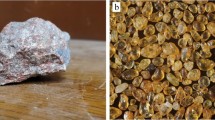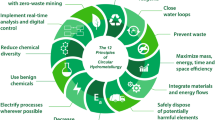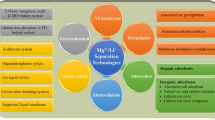Abstract
Mining of uranium for nuclear fuel production inevitably leads to the exhaustion of natural uranium resources and an increase in market price of uranium. As an alternative, it is possible to provide nuclear power plants with reprocessed spent nuclear fuel (SNF), which retains 90% of its energy resource. The main obstacle to this solution is related to the formation in the course of the reprocessing of SNF of a large volume of liquid waste, and the necessity to concentrate, solidify, and dispose of this waste. Radioactive waste is classified into three categories: low-, intermediate-, and high-level (LLW, ILW, and HLW); 95, 4.4, and 0.6% of the total waste are LLW, ILW, and HLW, respectively. Despite its small relative volume, the radioactivity of HLW is approximately equal to the combined radioactivity of LLW + ILW (LILW). The main hazard of HLW is related to its extremely high radioactivity, the occurrence of long-living radionuclides, heat release, and the necessity to confine HLW for an effectively unlimited time period. The problems of handling LILW are caused by the enormous volume of such waste. The available technology for LILW confinement is considered, and conclusion is drawn that its concentration, vitrification, and disposal in shallow-seated repositories is a necessary condition of large-scale reprocessing of SNF derived from VVER-1000 reactors. The significantly reduced volume of the vitrified LILW and its very low dissolution rate at low temperatures makes borosilicate glass an ideal confinement matrix for immobilization of LILW. At the same time, the high corrosion rate of the glass matrix at elevated temperatures casts doubt on its efficient use for immobilization of heat-releasing HLW. The higher cost of LILW vitrification compared to cementation and bitumen impregnation is compensated for by reduced expenditure for construction of additional engineering barriers, as well as by substantial decrease in LLW and ILW volume, localization of shallow-seated repositories in various geological media, and the use of inexpensive borosilicate glass.
Similar content being viewed by others
References
Advocat, T., Jollivet, P., Crovisier, J.L., and del Nero, M., Long-Term Alteration Mechanisms in Water for SON 68 Radioactive Borosilicate Glass, J. Nucl. Mater., 2001, vol. 298, pp. 55–62.
Barinov, A.S., Ojovan, M.I., and Ojovan, N.V., 7-Years Leaching Tests of NPP Vitrified Radioactive Waste, in Proceedings of Sympos. on Sci. Bas. Nucl. Waste Management XIX, Pittsburgh: MRS, 1996, vol. 412, pp. 265–270.
Barinov, A.S., Varlakova, G.A., Startseva, I.V., et al., Properties of Nuclear Waste Glass Form and Their Evolution During Long-Term Burial Testing, in Proceedings of Inter. Conf. on Chemistry and Migration Behaviour of Actinides and Fission Products in the Geosphere, Munich, 2007, p. 52.
Bazhenov, Yu.M., Dukhovich, F.S., Kulichenko, V.V., et al., Study of Conditions of Disposal of Radioactive Waste into the Ground, in Proceedings of Sympos. on Disposal of Radioactive Waste into the Ground, Vienna: IAEA and ENEA, 1967, pp. 409–417.
Corrosion and Alteration of Nuclear Materials, Paris: CEA, 2010.
Cowan, S.P., Overview of Current DOE Plans and Activities Involving Vitrification, in Glass As a Waste Form and Vitrification Technology, Washington, DC: Nat. Acad. Press, 1996, pp. E8–E9.
Cowan, R. and Ewing, R.C., Fresh Water Alteration of Basaltic Glass, Hanauma Bay, Oahu, Hawaii: a Natural Analogue for the Alteration of Borosilicate Glass in Fresh Water, in Proceedings of Sympos. on Sci. Bas. Nucl. Waste Management XII, Pittsburgh: MRS, 1989, pp. 49–56.
Croff, A.G., Identification and Summary of Characterization of Materials Potentially Requiring Vitrification, in Glass As a Waste Form and Vitrification Technology, Washington, DC: Nat. Acad. Press, 1996, pp. D1–D14.
Crovisier, J.L., Advocat, T., and Dussossoy, J.L., Nature and Role of Natural Alteration Gels Formed on the Surface of Ancient Volcanic Glass (Natural Analogs of Waste Containment Glass), J. Nucl. Mater., 2003, vol. 321, pp. 91–109.
Darab, J.G., Meiers, E.M., and Smith, P.A., Behavior of Simulated Hanford Slurries During Conversion to Glass, in Proceedings of Sympos. on Sci. Bas. Nucl. Waste Management XXII, Warrendale: MRS, 1999, vol. 556, pp. 215–222. End Points for Spent Nuclear Fuel and High-Level Radioactive Waste in Russia and the United States, Washington DC: Nat. Acad. Press, 2003.
Fosfatnye stekla s radioaktivnymi otkhodami (Phosphate Glass with Radioactive Waste), Vashman, A.A. and Polyakov, A.S., Eds., Moscow: TsNIIatominform, 1997.
Glasser, F.P., Characterisation of the Barrier Performance of Cements, in Proceedings of Sympos. on Sci. Bas. Nucl. Waste Management XXV, Warrendale: MRS, 2002, vol. 713, pp. 721–732.
Beard, S.J. and Godfrey, W.L., Waste Disposal into the Ground at Hanford, in Proceedings of Sympos. on Disposal of Radioactive Waste Into the Ground, Vienna: IAEA and ENEA, 1967.
Gorsky, V.V., Inert Mass Fuel (IMF), Atomnaya Tekhnika Za Rubezhom, 2000, no. 10, pp. 3–8.
Grambow, B., Nuclear Waste Glasses — How Durable?, Elements, 2006, vol. 2, no. 6, pp. 357–364.
Hrma, P.R. and Smith, P.A., The Effect of Vitrification Technology on Waste Loading, in Proceedings of Spectrum’94 Sympos., La Grange Park: ANS, 1994, pp. 862–867.
Kopyrin, A.A., Karelin, A.I., and Karelin, V.A., Tekhnologiya proizvodstva i radiokhimicheskoi pererabotki yadernogo topliva (Technology of Production and Radiochemical Reprocessing of Nuclear Fuel), Moscow: Atomenergoizdat, 2006.
Kuznetsov, V.M., Yadernaya opasnost. Osnovnye problemy i sovremennoe sostoyanie bezopasnosti predpriyatii yadernotoplivnogo tsikla v Rossiiskoi Federatsii (Nuclear Hazard: Main Problems and the Safety State of the Art at the Enterprises of Nuclear Fuel Cycle in the Russian Federation), 2nd Ed., Moscow: EPItsentr, 2003.
Laverov, N.P., Velichkin, V.I., Omel’yanenko, B.I., et al., Izolyatsiya otrabotavshikh yadernykh materialov: geologogeokhimicheskie aspekty (Confinement of SNM: Geological and Geochemical Aspects), Moscow: IFZ RAN, 2008.
Lifanov, F.A., High-Temperature Conditioning of LLW and ILW, Doctoral (Techn.) Dissertation, Moscow: Radiochem. Techn. Univ., 2000.
Lutze, W., Silicate Glasses, in Radioactive Waste Forms for the Future, New York: Elsevier, 1988, pp. 1–60.
Lutze, W., Malow, G., Ewing, R.C., et al., Alteration of Basaltic Glasses: Implications for Modeling the Long-Term Stability of Nuclear Waste Glasses, Nature, 1985, no. 314, pp. 252–255.
Men’shikov, V.F., Radioactive Waste of Nuclear Energetics of Russia, in Yadernaya entsiklopediya (Nuclear Encyclopedia), Moscow: Blagotvoritel’nyi fond Yaroshinskoi, 1996, pp. 231–239.
Mitsui, S. and Aoki, R., Effect of a Siliceous Additive on Aqueous Alteration of Waste Glass with Engineered Barrier Materials, J. Nucl. Mater., 2001, vol. 298, pp. 184–191.
Nuclear Waste Conditioning, Paris: CEA, 2009.
Ojovan, M.I., Hand, R.J., Ojovan, N.V., and Lee, W.E., Corrosion of Alkali-Borosilicate Waste Glass K-26 in Non-Saturated Conditions, J. Nucl. Mater., 2005, vol. 340, pp. 12–24.
Ojovan, M.I., Lee, W.E., Barinov, A.S., et al., Corrosion Mechanisms of Low-Level Vitrifier Radioactive Waste in Loamy Soil, in Proceedings of Sympos. on Sci. Bas. Nucl. Waste Management XXVIII, Warrendale: MRS, 2004, vol. 824, pp. 333–338.
Ojovan, M.I., Ojovan, N.V., Startceva, I.V., et al., Waste Glass Behavior in Loamy Soil of a Wet Repository Site, J. Nucl. Mater., 2001a, vol. 298, pp. 174–179.
Ojovan, M.I., Ojovan, N.V., Startceva, I.V., et al., Experiment-Based Prognostication of Waste Borosilicate Glass Behavior in a Loamy Soil of the Wet Repository Site, in Proceedings of WM’01 Conf., February 25–March 01, Tucson, 2001b, CD-rom.
Omel’yanenko, B.I., Petrov, V.A., and Poluektov, V.V., Behavior of Uranium under Conditions of Interaction of Rocks and Ores with Subsurface Water, Geol. Ore Deposits, 2007, vol. 49, no. 5, pp. 378–391.
Radioactive Waste Forms for the Future, New York: Eslevier, 1988.
Rybal’chenko, A.I., Pimenov, M.K., Kostin, P.P., et al., Glubinnoe zakhoronenie zhidkikh radioaktivnykh otkhodov (Deep Disposal of Liquid Radioactive Waste), Moscow: IzdAT, 1994.
Sobolev, I.A., Barinov, A.S., and Ojovan, M.I., Field Testing of Solidified Radioactive Waste, At. Energ., 1990, vol. 69, no. 5, pp. 306–309.
Sobolev, I.A., Dmitriev, S.A., Barinov, A.S., et al., 39-Years Performance of Cemented Radioactive Waste in a Mound-Type Repository, in Proceedings of Sympos. on Sci. Bas. Nucl. Waste Management XXIX, Warrendale: MRS, 2006, vol. 932, pp. 721–726.
Sobolev, I.A., Khomchik, L.M., Bazhenov, Yu.M., et al., Testing Disposal of LLW in Clay Ground at the Moscow Station, Proceedings of Sympos. on Disposal of Radioactive Waste into the Ground, Vienna: IAEA and ENEA, 1967, pp. 37–46.
Sobolev, I.A., Lifanov, F.A., Stefanovsky, S.V., et al., Neutralization of Liquid Radioactive Waste, Steklo Keram., 1988, no. 6, pp. 401–405.
Sobolev, I.A., Ojovan, M.I., Batyukhnova, O.G., et al., Waste Glass Leaching and Alteration Under Conditions of Open Site Tests, in Proceedings of Sympos. on Sci. Bas. Nucl. Waste Management XX, Pittsburgh: MRS, 1997, vol. 465, pp. 245–252.
Sobolev, I.A., Ojovan, M.I., Shcherbatova, T.D., and Batyukhnova, O.G., Stekla dlya radioaktivnykh otkhodov (Glass for Radioactive Waste), Moscow: Energoatomizdat, 1999.
Sombret, C.G., Waste Forms for Conditioning High Level Radioactive Solutions, in The Geological Disposal of High Level Waste, Athens: Theophilus Publ., 1987, pp. 69–160.
Spitsyn, V.I., Pimenov, M.K., Yudin, F.P., and Balukova, V.D., Scientific Prerequisites for Utilizing Deep-Lying Formations for Burying Liquid Radioactive Waste, in Proceedings of Sympos. on Disposal of Radioactive Waste Into the Ground, Vienna: IAEA and ENEA, 1967, pp. 574–577.
Spitsyn, V.I., Pimenov, M.K., Balukova, V.D., et al., Main Prerequisites and Practice of Utilizing Deep-Lying Formations for Burying Liquid Radioactive Waste, At. Energ., 1978, vol. 44, no. 2, pp. 161–168.
Velikhov, E.P., Safety Hazard, Vokrug Sveta, 2003, no. 7, pp. 3–7.
Verney-Carron, A., Gin, S., and Libourel, G., Archaelogical Analogs and the Future of Nuclear Waste Glass, J. Nucl. Mater., 2010, vol. 406, pp. 365–370.
Wicks, G.G., US Field Testing Programs and Results, J. Nucl. Mater., 2001, vol. 298, pp. 78–85.
Zakharov, S.I., Bagretsov, V.F., Pimenov, M.K., et al., Some Results of Pilot Operation of the Plant for Confinement of Liquid Radioactive Waste in Deep-Seated Formations of the Earth’s Crust, in Proceedings of Sympos. on Disposal of Radioactive Waste into the Ground, Vienna: IAEA and ENEA, 1967, pp. 577–588.
Zotov, A.V., Levin, K.A., Omel’yanenko, B.I., et al., Interaction of Aluminophosphate Glass with Water at Elevated Temperatures, Geokhimiya, 1996, vol. 34, no. 9, pp. 891–904.
Author information
Authors and Affiliations
Corresponding author
Additional information
Original Russian Text © N.P. Laverov, B.I. Omel’yanenko, S.V. Yudintsev, S.V. Stefanovsky, 2012, published in Geologiya Rudnykh Mestorozhdenii, 2012, Vol. 54, No. 1, pp. 3–21.
Rights and permissions
About this article
Cite this article
Laverov, N.P., Omel’yanenko, B.I., Yudintsev, S.V. et al. Confinement matrices for low- and intermediate-level radioactive waste. Geol. Ore Deposits 54, 1–16 (2012). https://doi.org/10.1134/S1075701512010059
Received:
Published:
Issue Date:
DOI: https://doi.org/10.1134/S1075701512010059




